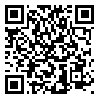

Volume 6, Issue 17 (Summer 2023)
J Altern Vet Med 2023, 6(17): 1017-1027 |
Back to browse issues page
Download citation:
BibTeX | RIS | EndNote | Medlars | ProCite | Reference Manager | RefWorks
Send citation to:



BibTeX | RIS | EndNote | Medlars | ProCite | Reference Manager | RefWorks
Send citation to:
Ojaghloo M R. Ultrasonographic Assessment of Migrating Vegetal Foreign Bodies in Pancreas of Dog. J Altern Vet Med 2023; 6 (17) :1017-1027
URL: http://joavm.kazerun.iau.ir/article-1-150-en.html
URL: http://joavm.kazerun.iau.ir/article-1-150-en.html
Department of Surgery and Radiology, Faculty of Veterinary Medicine, University of Tehran, Tehran, Iran , m.r.ojaghloo@ut.ac.ir
Abstract: (252 Views)
Background and aim: Grass thorns are a common cause to migrate foreign body disease in animals, but little is known about their presence in pancreas. The disease is more common in dogs than in cats, and is especially common in large and long-haired dogs. Ultrasonography is useful for diagnosing the vegetal foreign bodies in dogs and cats. Ultrasound characteristics of the grass thorns in vivo and in vitro have been described in detail. In this study, the ultrasonography of migrating vegetal foreign bodies in the pancreas of two dogs is explained.
Materials and Methods: Two male terriers were evaluated for signs of acute pancreatitis and tested for blood analysis and imaging. The results of clinical examination, blood cell count, serum biochemistry and ultrasound were recorded and chest and abdominal radiographs were also evaluated.
Results: Based on the evaluation of ultrasound, a vegetal foreign body was observed in the vicinity of the right lobe of the pancreas. This structure was seen on ultrasound as a linear hyperechoic structure with acoustic shadowing. The presence of a grass thorn in the pancreatic lobe was confirmed during exploratory laparotomy, and the clinical signs improved completely with its removal.
Conclusion: According to this report, ultrasonography represented a high diagnostic accuracy with the possibility of correct assessment for secondary lesions in the pancreas and correct identification and localization of the foreign bodies in it, and determined the position of the grass thorn correctly before the operation. Therefore, ultrasonography is expected to be considered as an efficient diagnostic tool in diagnosing the vegetal foreign bodies.
Materials and Methods: Two male terriers were evaluated for signs of acute pancreatitis and tested for blood analysis and imaging. The results of clinical examination, blood cell count, serum biochemistry and ultrasound were recorded and chest and abdominal radiographs were also evaluated.
Results: Based on the evaluation of ultrasound, a vegetal foreign body was observed in the vicinity of the right lobe of the pancreas. This structure was seen on ultrasound as a linear hyperechoic structure with acoustic shadowing. The presence of a grass thorn in the pancreatic lobe was confirmed during exploratory laparotomy, and the clinical signs improved completely with its removal.
Conclusion: According to this report, ultrasonography represented a high diagnostic accuracy with the possibility of correct assessment for secondary lesions in the pancreas and correct identification and localization of the foreign bodies in it, and determined the position of the grass thorn correctly before the operation. Therefore, ultrasonography is expected to be considered as an efficient diagnostic tool in diagnosing the vegetal foreign bodies.
Type of Study: case report |
Subject:
Radiology
Received: 2023/06/26 | Accepted: 2023/08/7 | Published: 2023/09/1
Received: 2023/06/26 | Accepted: 2023/08/7 | Published: 2023/09/1
Send email to the article author
| Rights and permissions | |
 |
This work is licensed under a Creative Commons Attribution-NonCommercial 4.0 International License. |




